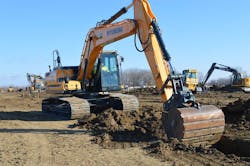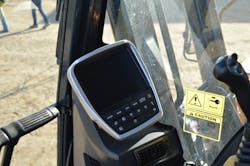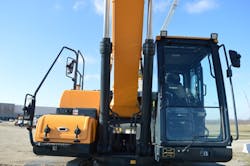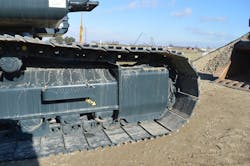Hard-Digging Hyundai HX220L Tackles Frosty Ground
On a cold December day punctuated with biting winds, Construction Equipment editors visited the International Union of Operating Engineers Local 150 training center in Wilmington, Illinois, to witness an independent operator/instructor and a second-year apprentice evaluate the feature-filled Hyundai HX220L crawler excavator.
Hyundai has packed the machine not only with technology, but also with practical touches in areas such as convenience, serviceability, and safety—and their presence is prominent.
Introduced in 2015, the HX220L is a 173-horsepower unit, part of the company’s H Series that has replaced the 9A Series. In going to the new series, Hyundai made some key changes, says Chad Parker, the senior product specialist and sales trainer who was on hand for Hyundai.
“Hyundai was able to increase cycle times by 13 percent over the previous model and decrease fuel consumption by 10 percent,” Parker says.
A major contributor to the improvements is Hyundai’s Intelligent Power Control system that provides computer-aided optimization based on load demand. It automatically adjusts engine rpm and hydraulic flow to find the spot for maximum productivity and fuel economy.
The Local 150 test site and the time of year combined to put the system to an immediate test.
Martin Taylor, an operator/instructor with Local 150, was eager to attack the frosty ground. He set about digging a 3-foot trench with the help of a Werk-Brau 1.2-cubic-yard bucket on a hydraulically operated Hyundai-branded quick-attach coupler.
“Once you put a 48-inch bucket on it, that’s your max on this size machine with a coupler,” Taylor says. “And this will be buckets of hard clay, compacted for months. It’s like you’re digging virgin clay.”
As Parker points out, a bucket on the end of a coupler pushes the pivot point outward, which can impact breakout force, and provides a true test.
“I took the frost out of it, eight, maybe 10 inches of frost, and that machine handled it, no problem at all,” Taylor says. “I was strictly in the power mode; I always run the machine in the power mode. It was smooth, and had clean actions. It’s a well-balanced machine.”
The HX220L has a Cummins QSB6.7 engine and three power modes: Power, for heavy work; Standard, to optimize performance; and Economy, which is meant to improve control and efficiency for light work.
Though Taylor is a self-professed “power guy,” he powered down into standard when he had a particular task in mind.
“I also changed down to the smoother motion to scratch dirt in the bottom of the trench, and I didn’t feel a lot of difference in the modes or performance,” Taylor says.
The excavator’s Fine Swing feature reduces possible swing shock when swinging under load at slower speeds. But it wasn’t long until Taylor was back in power mode.
“I wanted to take a big load in the bucket and turn the undercarriage to test stability over the side,” Taylor says. “It felt good, it’s a very solid piece of equipment. With a fully loaded bucket, a large bucket like that, it was very, very steady. It would be good on slopes.
“I wanted to see what it could do, I really did want to see if I’m going to get light on the rear end of it, but it held up well over the side,” Taylor says. “It had all the stability in the world—because I will push them to the limits.”
Mark Perfetti, a second-year apprentice at Local 150 who also works for Grimmer Construction in Highland, Indiana, tackled the frost, too. He took time from a basement-digging class to help with the evaluation.
“Of the three modes, the power mode did the best, digging in the frost,” Perfetti says. “I know the lower rpm for economy mode saves fuel and that, but the power mode dug pretty well in the 10 to 12 inches of frost where I was.”
Both operators also tested the machine’s speed and movement during truck loading, looking to gauge the feel.
“I think it was precise enough,” Pefetti says. “I think the hydraulics acted well enough with the sticks. It was minimal effort to work the sticks. I liked the quickness and the response time. You can set the hydraulic speed for the boom and the stick, and I think it was set right because the stick seemed to move real well.”
Taylor agreed. “As far as response and speed, it’s on par, as good, if not better, than anything else we have out here in the weight class. That’s every make and model. If you took all the names off them, people wouldn’t know the difference,” he says.
Another feature that debuted with the HX Series is Attachment Flow Control, which gives the operator independent control of two pumps. It is designed to optimize flow-rate settings according to attachment type (10 breaker types and 10 crusher types). Dual auxiliary piping extends down the boom and comes pre-plumbed from the factory for attachment use. Parker says the boom and boom arm give the excavator 37,000 lb.-ft. of lifting power and 26,000 lb.-ft. of crowd force. The 51,500-pound unit has a larger counterweight standard for extra balance and stability.
Perhaps the biggest hallmark of the HX Series is the 8-inch touchscreen monitor, and the haptic, automotive-style control that goes with it. The monitor seemingly shows and does just about everything. Operators can change views and make adjustments from either the monitor or the haptic control located next to the seat.
The monitor is 15 percent larger than its predecessor and is a cluster of electronic controls and monitoring functions. Displays include real-time readings on items like operation data, and fuel consumption. There is also access to many operator-settable functions.
“Whenever I wanted to change anything, I used the touchscreen in front of me,” Perfetti says. “That’s something I do like about the machine, that the monitor is moveable. On most machines, they are fixed, but this one is moveable up and down and sideways. There are no problems seeing it in the sunlight. You can’t see shadows or anything on it.”
The monitor can be adjusted vertically up to 30 degrees and horizontally up to 8 degrees.
There’s even an inclinometer that shows whether or not the machine is level. Taylor was keen to try it out.
“On the monitor, you have a little level bubble,” Taylor says. “Some guys will tell you from their years [operating] they can tell when the machine’s level. Now I’ve been doing it for years, but I actually like that feature.
“At one point, I dug out under one of my tracks to test it out and see what it would look like when I came back over it, and [the inclinometer] told me right away,” Taylor says. “It’s nice to have on the machine. You don’t have to second-guess yourself, it’s right there.”
Interestingly, neither operator chose to use the haptic control, preferring the touchscreen monitor.
“That dial is near the armrest, and with the armrest down it’s a little harder to see unless you take the time to find it,” Perfetti says. “Here with the monitor [in front], you can operate it while you’re digging, you just reach out from the stick and hit the button to go where you want to go. That dial’s down and off to the side.”
Taylor concurs. “It’s right in front of you, so it’s one touch and you’re reset.”
Another change from the previous series is the cab. “The cab is larger, with 13 inches more room, really lengthening the floor space,” Parker says. A heated, air-suspension seat with numerous adjustment points is standard, and cab glass extends from the ceiling to the floor. In addition, there’s a sun/moon roof section above, with a sunshade, and the bottom panel beyond the foot pedals is removable.
“The seat is very comfortable, and when you adjust it, everything moves together. It’s nice to have that,” Taylor says. “And the visibility out of that cab is awesome, second to none,” Taylor says. “It’s probably one of the better machines on the market right now.”
Taylor was also impressed with the visibility as he worked his trench. “The view down into the trench was really good because the glass is really big, especially the lower part down by your feet,” he says. “It seems like [you can see] the full width of the cab across and all the way down to the floor.”
Serviceability
Hyundai has paid special attention to serviceability on the HX Series. Right next to the cab door, accessible from ground level, is a door containing the AC filter, and in a splash of practicality, its door doubles as a splash guard against water that could otherwise penetrate the area during pressure washing.
Behind the next ground-level door over sits the two-stage air cleaner with a precleaner on top, the battery-disconnect switch, and the pattern changer, which allows operators to switch to either ISO or SAE controls.
Continue walking next to the unit and the third door reveals aluminum, open-core coolers, meant to resist corrosion. Also inside is the radiator and hydraulic oil coolers, and an aftercooler is on top. The excavator’s batteries are at the bottom of the compartment.
On the left side of the unit, another door reachable from ground level reveals the Kawasaki pump. Hyundai has Parker test ports on all the pumps to help technicians check pressure and flow. The same compartment contains the fuel filter and engine oil filter, which is remote-mounted. At the top is the SCR unit and the DOC. The HX220L achieves Tier 4-F without the use of a DPF.
The DEF fill is nearby, behind a locked door. A handy LED light helps to prevent overfilling.
Numerous features protect the undercarriage from rocks and dirt. “The undercarriage is designed and built by Hyundai,” Parker says. There are steel plates on each side of the undercarriage to help keep material out of the roller area and keep the tracks on the rollers. The undercarriage features nine roller bearings and two protected carrier rollers. Parker also points out that the hydraulic cylinders, drive motors, and other key components are made by Hyundai. “The benefit is that access to parts or replacement is easy, and everything is OEM-branded,” he says. “All the hoses are laid out really nice, and tagged and part-numbered for easy recognition.”
There are more practicalities built in for safety that both operators and technicians would like. Below the cab, there are evenly placed dual steps, an outer and an inner, to help operators climb into the cab. One is welded to the frame, the other is bolted on, just outside the first. This makes the step protrude further outward, keeping the operator’s legs a bit outside the track.
“It helps prevent your shins from hitting the track,” Parker says. “That’s going to save some bruises.”
Another improvement over the 9A Series is the upper guardrails added on the left and right at the top of the machine. They are 50 inches high. “Falls are still one of the most common injuries around equipment,” Parker says. On the top of the undercarriage, Hyundai added anti-slip pads with its own proprietary raised pattern. A rear-view backup camera is standard equipment.
Though the particular model Local 150 tested didn’t have it, it’s worth noting that Hyundai offers another safety feature, an optional All Around View Monitoring camera system consisting of four external cameras that provide a composite, 360-degree bird’s eye view of the operating environment. Integrated with this feature is Intelligent Moving Object Detection, which is a system that warns operators with an audible and visible alarm when objects are detected within a 16.5-foot radius of the machine.
The system is yet another function for the excavator’s high-tech multitasking monitor.
CE asked Taylor if there is such a thing as too many informational displays or too much technology in a machine. “I wouldn’t think so, because it’s very simplified,” he says.
“There’s a lot there, but it’s not Windows Vista.”





